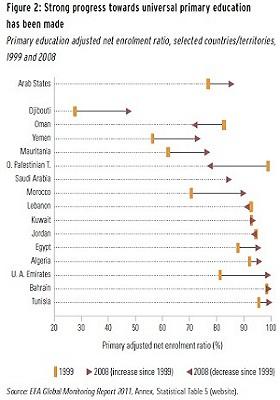Using AI to control energy for indoor agriculture
30 September 2024
Published online 2 March 2011

Most Arab states have made progress in providing education over the past decade. However, the quality of education remains poor, many children still leave primary education prematurely and illiteracy rates are relatively high, says a new United Nations Educational, Scientific and Cultural Organization (UNESCO) report.
The hidden crisis: Armed conflict and education reviews the progress on education, and warns that many regions will not meet commitments set for 2015 for Education for All, a UNESCO initiative launched to provide education to every citizen in every society.
The regional report for the Arab States finds that that the proportion of children attending school has increased, with average enrollment reaching 86%, up from 75% of children in 1999. Yet, six million primary school-aged children remain out of school, the majority of whom are girls. The occupied Palestinian territories has witnessed a huge fall in primary school enrollment of 21%.
Between 1999 and 2005, Yemen, one of the world's poorest countries, has seen a large increase in enrollment. In 2008, it had over one million children out-of-school, the highest number in the region. This increase has slowed over the past few years, however, which means that number could increase before 2015.
In 2008, enrollment in third-level education in the Arab world was 21%, lower than the world average of 26%. With rates of tertiary education rising rapidly in other developing areas of the world, such as Latin America and East Asia, this puts the Arab world at a disadvantage in an increasingly knowledge-based global economy.
"The real problem is that education in public universities has deteriorated to a degree where the graduates don't meet the needs of the job market," said Alaa Ibrahim, an astrophysicist at the American University in Cairo, Egypt.
Students must rely on free online educational material, or take additional courses after graduation, to be more competitive, he added.
The report also criticizes the quality of education in Arab countries. In the 2006, Progress in International Reading Literacy Study (PIRLS), an international comparative study of the reading literacy of young students, ranked all Arab countries, including the rich Gulf States, among the worst performers. In Morocco, for example, a majority of students had not acquired basic reading skills after four years of primary education.
The increase in number of educated adults, however, has brought child mortality down over the past 10 years. Better access to reproductive health information and fewer children have helped mothers provide better nutrition and care to their children. Rates of child mortality in families with some secondary educations were half those in uneducated households.
While the literacy rate has been rising in the region, it has not risen fast enough to meet the population growth. The number of adult illiterates is still rising, reaching 60 million in 2008, 18 million of whom live in Egypt. Women have been disproportionately affected in most countries, with over 70% of illiterates in Yemen, Libya, Jordan and the occupied Palestinian territories being women.
Bahrain, Jordan, Kuwait, Lebanon, Qatar, the United Arab Emirates and the Occupied Palestinian Territories all had literacy rates above 90%.
Many parts of the Arab world have endured, or continue to endure, armed conflict. This has had a strong impact on education. Military spending may often come at the expense of education. Physical and psychological injury sustained by students during these events can have a lasting effect on education.
The report cites evidence gathered in Gaza that identifies conflict-related post-traumatic stress disorder as a frequent cause of impaired learning. During the Gaza war in December 2008, 262 schools were damaged and 18 destroyed. In Yemen, armed conflict between government forces and rebels in 2009 and 2010 shut over 700 schools for five months.
Iraq, which was a regional leader in education before the early 1990s, is another example. Following the first Gulf War, years of crippling international sanctions culminating in the US-led invasion has pushed the country below most others in the region.
doi:10.1038/nmiddleeast.2011.26
Stay connected: